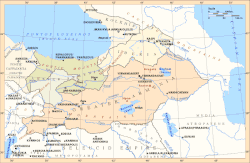Satrapy of Armenia
Satrapy of Armenia Սատրապական Հայաստան 𐎠𐎼𐎷𐎡𐎴 | |
|---|---|
| 570 BC–321 BC | |
 Territory of the Orontid Dynasty in IV-II BC | |
| Status | Satrapy |
| Capital | Tushpa Erebuni |
| Common languages | Armenian Persian Aramaic (South) Median (East) |
| Religion | Armenian polytheism Zoroastrianism[1] |
| Government | Monarchy |
| Satrap | |
| History | |
• Established | 570 BC |
• Disestablished | 321 BC |
The Satrapy of Armenia, (Armenian: Սատրապական Հայաստան, Satrapakan Hayastan; Old Persian: 𐎠𐎼𐎷𐎡𐎴, Armina) was an Armenian satrapy controlled by the Orontid dynasty. Armenia is one of the satrapies of the Achaemenid Empire in the 6th century BC that later became an independent kingdom.
Origins[change | change source]
The Orontid dynasty, also known by their native name Eruandid or Yervanduni, was a hereditary Armenian[2][3][4] dynasty and the rulers of the Satrapy of Armenia. Most historians say the Orontids are of Iranian origin.[5][6][7][8][9][10] It is suggested that it held dynastic familial linkages to the ruling Achaemenid dynasty.[8][11]
Panossian states the following about the Orontids (Yervandunis);[12]
"It is not known whether the Yervandunis were ethnically Armenian. They probably had marriage links to the rulers of Persia and other leading noble houses in Armenia."
References[change | change source]
- ↑ Russell (1986), p. 51.
- ↑ Lang 1983, p. 535.
- ↑ Versluys 2017, p. 48.
- ↑ Maranci 2018, p. 21.
- ↑ Toumanoff 1963, p. 278.
- ↑ Garsoian 2005.
- ↑ Gaggero 2016.
- ↑ 8.0 8.1 Allsen 2011, p. 37.
- ↑ Facella 2021.
- ↑ Russell 1986, p. 438–444.
- ↑ Payaslian 2007, p. 8-9.
- ↑ Panossian 2006, p. 35.
Sources[change | change source]
- Versluys, Miguel John (2017). Visual Style and Constructing Identity in the Hellenistic World: Nemrud Dağ and Commagene under Antiochos I. Cambridge University Press. p. 48. ISBN 978-1-107-14197-1.
Most scholars assume that Ptolemy was the first Commagenean king and that he descended from the Armenian Orontids.
- Panossian, Razmik (2006). The Armenians From Kings and Priests to Merchants and Commissars. United Kingdom: Columbia University Press. pp. 35. ISBN 9781850657880.
It is not known whether the Yervandunis were ethnically Armenian. They probably had marriage links to the rulers of Persia and other leading noble houses in Armenia.
- Lang, David M (1983). Yarshater, Ehsan (ed.). The Cambridge History of Iran, Vol. 3. The Seleucid, Parthian and Sasanian Periods. Cambridge University Press. p. 535. ISBN 0-521-20092-X.
Here a scion of the Armenian Orontid house, King Antiochus I (...) Armenian dynasty of the Orontids.
- Maranci, Christina (2018). The Art of Armenia: An Introduction. Oxford University Press. p. 20. ISBN 978-0-19-093588-7.
(...) the Armenian dynasty of the Yervandids (Orontids).
- Toumanoff, Cyril (1963). Studies in Christian Caucasian history. Washington DC. Georgetown University Press. p. 278.
- Facella, Margherita (2021). "Orontids". Encyclopædia Iranica.
- Payaslian, Simon (2007). The history of Armenia : from the origins to the present (1st ed.). New York: Palgrave Macmillan. pp. 8–9. ISBN 978-1403974679.
- Garsoian, N. (2005). "TIGRAN II". Encyclopæedia Iranica.
- Russell, J.R. (1986). "Armenia and Iran iii. Armenian Religion". Encyclopædia Iranica. pp. 438–444.
- Allsen, Thomas T. (2011). The Royal Hunt in Eurasian History. University of Pennsylvania Press. p. 37.
- Gaggero, Gianfranco (2016). "Armenians in Xenophon". Greek Texts and Armenian Traditions: An Interdisciplinary Approach. De Gruyter.
